Friday, June 3
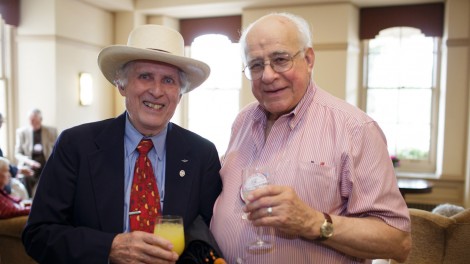
4:10 p.m.
Wayne Erb ’56 and John Salvador ’56
More than 1,200 alumni from across the country came home to Lafayette for Reunion Weekend June 3-4 to reconnect with old friends, reminisce about good times and revisit a campus that continues to evolve and expand in exciting ways. This year’s event hosted classes ending in one and six. Below are a few highlights from the weekend.

Wayne Erb ’56 and John Salvador ’56
John Salvador ’56 and Wayne Erb ’56 went to kindergarten in Schenectady, N.Y. Then came grammar school, high school, and finally four years at Lafayette.
So, of course, they stroll into the lobby of Pardee Hall side by side for their 60th college reunion.
“There used to be a whole Schenectady contingent,” Erb says, glancing around at the other gray- and silver-headed members of the 50-Plus Club. “I haven’t seen any of them.”
Salvador, the quieter of the two men, had majored in civil engineering. He’d been president of the student council and won the College’s prestigious George Wharton Pepper Prize in 1956. He made a career of engineering and now lives on Lake George.
Erb became a pilot first for the Army and later for United Airlines.
“They gave him a badge,” Salvador quips, “it says ‘Unsafe at Any Altitude.’”
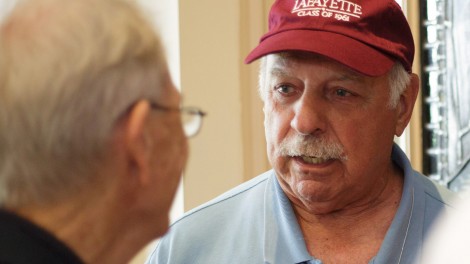
Jim Sorrentino '61
In a nearby corner of the Pardee lobby, Jim Sorrentino is huddling with former classmates and 1961 grads Lew Gil and Dick Webster when he’s asked to recount the circumstances that brought him to Lafayette.
“It was football,” says Sorrentino.
In high school, Sorrentino played running back and one day the coach of a rival team asked if he’d like to join some of his players on a recruiting trip to Lafayette. Sorrentino said sure, what did he have to lose? When he got to campus he liked what he saw, applied, and received a scholarship.
“I’m the son of a true immigrant from Italy,” says Sorrentino, who received his J.D. from Cornell University in 1964 and practices law in Lancaster, Pa. “There was no way I could have afforded tuition and books without help from the college. I’m grateful. I got a tremendous education at a tremendous school.”
His college football career lasted one year after he realized there was little chance he’d get in a game as long as the 6-foot-tall, 200-pound Charles Bartos ’60 started at running back. Employing the same strategic mentality that has made him a successful litigator, Sorrentino decided to cut his losses. “My choice was to sit on the bench or play in a band and make some money and maybe meet a girl,” he says.
“There were no girls when we were here,” Webster, a retired professor of history and American studies at West Chester University, chimes in, as if to confirm his friend’s good decision.
Forty-five years later, Sorrentino is still playing drums and making a case for Lafayette.
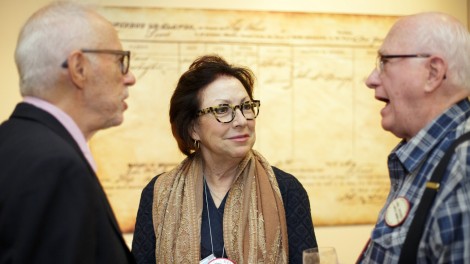
Dick Wilson ’56, right, is back on campus for the first time in 60 years.
Ron Keyser ’56 of Hagerstown, Md., sits with a rapt knot of listeners transfixed by a man wearing a flannel shirt and suspenders. “My old roommate,” says Keyser, who had come to Lafayette on scholarship and majored in chemistry.
Dick Wilson ’56, who was known as Battistic before taking his step-father’s last name, hasn’t set foot on the campus in 60 years.
Everything at Lafayette seems smaller to Wilson than he remembers. But bigger at the same time, somehow. Sixty years ago, the Quad seemed never ending as he sprinted across it, late for class. Pardee Hall seemed massive as he bounded up four flights of stairs to make his English course on time.
Now, as he crosses it on two surgically replaced knees, the Quad seems like a postage stamp. New buildings rise up near Pardee and Hogg Hall.
He obtained a degree in history.
Prof. W. Edward Brown used to stroll into class in his tweed jacket and speak conversationally about Greek history from memory. Wilson still credits the man with instilling in him a love for Greek and Roman history.
After graduation, Wilson’s life looked like a high-tech version of Homer’s “The Odyssey.”
He joined the Army. “They took one look at that history degree and decided, ‘You’d make a great engineer.’” He was stationed in Germany, working for the Army Security Agency – which was the military branch of the National Security Agency.
He later landed a job with AMPEX, the California company that invented the tape recorder.
It was the start of a herky-jerky life. He married a ballerina from Nebraska, went back to Europe and to Washington, D.C., for a time. Eventually, he followed a man who claimed to have invented a micro-computer to Boise, Idaho. The invention turned out to be fraudulent. Looking for work, Wilson became the computer guy for the stone-age Idaho State Legislature, which at the time had no computers and seemed hostile to the idea.
When he retired, in 1998, there were laptops and Oracle servers and Ethernet connections.
He’d been too busy bouncing around to attend any reunions. Finally, after 60 years, he decided it was time to return to Lafayette.
As he arrived on campus, looking through the crowd, he saw a familiar face.
“I recognized him right away,” he said, pointing at Keyser. He held a hand to his chin. “From here up, it’s the same.” He pointed to his belly. “From here down, it’s completely different. But who am I to talk?”
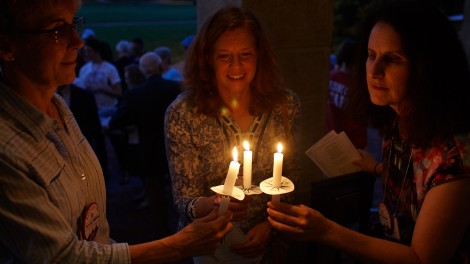
Alumni light candles before the step singing by Pardee Hall.
John Floyd-Jones ’84 and his wife Jamy Galliker Floyd ’86 are standing outside Pardee Hall as a small group of alum holding candles gather on the storied steps for the annual singing of the Alma Mater. The couple isn’t there to sing, but they take a few minutes to recall their first meeting.
“We met at a party,” says Floyd-Jones, who goes by FJ. “She was wearing a strawberry sundress.”
“He was immediately smitten,” laughs Jamy.
The couple have three children. The sundress is long gone.

The singing of the "Alma Mater" begins.
Someone starts.
“Way down in Easton, there’s a college, and Lafayette is her name …”
Figures wander toward Pardee from the twilight-enshrouded Quad to join in. One, a man in a blue blazer with a Lafayette ball cap, has a baritone voice that lifts above the makeshift choir.
“Come join our song to Lafayette, sir …” Clayton Ames ’66 knows all the words.
“I better,” he says. “I’ve been singing them for 54 years.”
Ames, who majored in literature and history, was a member of the College’s glee club. In the days before Lafayette admitted women, 77 young men were members.
“That’s how many we could fit on the bus,” Ames explains.
In those days, when the football team won, the club sang, “Ring the Bell of Old South College.” After losses, they sang “The Alumni Hymn.”
“We sang the Alumni Hymn a lot,” Ames says.

George Halak '61, Fred Bailine '61, Warren Eberlein '61, Bill Buehler '61, Annette Bailine, Dave Bloys '61, Sharon Buehler, Debi Bloys, and Jan Eberlein pose with the Leopard before the Alumni Parade.
The annual Alumni Parade is about to begin in front of Farinon and the brothers of Phi Delta Theta, Class of 1961, are trying to recall highlights of the glory days.
“When the DKE house burned down,” jokes Bill Buehler, an industrial engineering major who rose to vice chairman of Xerox before retiring in 2001.
“After that we got rats in the house,” says Warren Eberlein, who eventually joined Buehler at Xerox.
“Well they had to live somewhere,” notes George Halak, a defense contractor who has retained the stocky build he sported playing half back in college.
The rat comment reminds Annette Bailine of the first apartment she and husband, Fred Bailine, shared as a married couple during his senior year. “You’d plug in the toaster and the whole place would go black,” says Annette Bailine, who was working at the time as a nurse at Easton Hospital.
“Remember I’d cook so much spaghetti for you guys you’d practically choke trying to eat it all,” she says.
The men smile recalling their salad or spaghetti days. Despite or perhaps because of those lean times, the men have all had successful careers. Fred Bailine became vice president of Union Carbide. Eberlein earned an MBA from UCLA and retired from Xerox as systems support manager. Halak has earned accolades from the U.S. Department of Defense for his work with NATO. Another brother, Dave Bloys, founded a data processing firm in Bethlehem, Pa.
Buehler then recalls another memory. “Robert Frost,” he says. The poet came to campus and held court in Skillman Library, declining to shed clarity on his work. “He said, ‘It’s whatever it means to you,’ ” Buehler says.
Poetry aside, to the boys of ’61 Lafayette has meant the world.
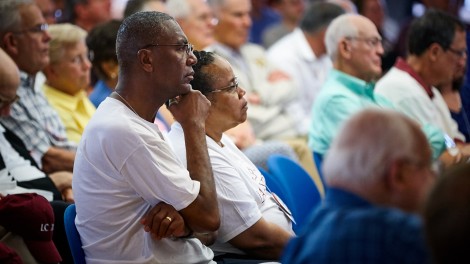
Andre ’76 and Winona McDaniel at President Byerly's State of the College address
Winona McDaniel is standing outside Farinon with a bag from the book store filled with gifts for her grandchildren. She’s waiting for her husband, Andre ’76, who is marching in the alumni parade. Winona graduated from Muhlenberg College in Allentown, but she has fond memories of attending Lafayette football games where Andre played wide receiver and kicker.
“It’s like you never left here when you come back,” she says, wearing a white Class of 1976 T-shirt.
This is the first reunion the couple has attended, and Andre, in a matching T-shirt fresh from parade duty, credits the 150th Rivalry game in Yankee Stadium two years ago for reconnecting him to his alma mater.
“We had an awesome time,” says Andre, CFO of a behavioral health company in Virginia. “It got me thinking it was time to go back.”
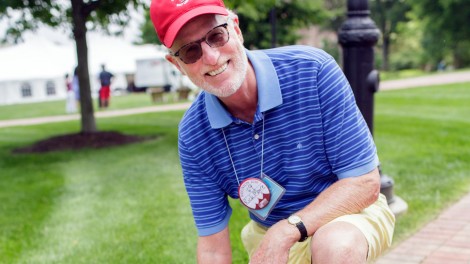
Rick Moore ’69 looks for his Fleck Society brick on the Quad.
Rick Moore ’69 is searching for the brick bearing his name along the pathway outside Skillman Library.
“I found my roommate and two other Chi Phi fraternity brothers, Tom Bradshaw and Ed Ahart,” chairman of Lafayette’s Board of Trustees and a ’69 grad like Bradshaw, who has passed away.
Moore received his brick after establishing a scholarship to benefit a student who shares his major of civil engineering. “It’s important to me to contribute to the college and help offset someone’s tuition costs,” he says.
He eventually finds his brick, but that’s not what brought him to Reunion, he says. On Friday, he participated in a golf tournament benefiting a scholarship fund established by the fraternity in memory of one of its own, Brian Keller ’16. Keller, an engineering major and No. 80 on the football team, died last year in a car accident. Moore says about 50 people participated in the tournament.
“We feel passionate about the college and fraternity,” he says.
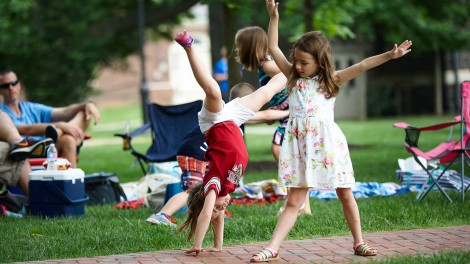
Alumni and their families have some fun on the Quad.
Steve Batta ’91, wife and three children in tow, march slowly to the family’s GMC Acadia for the trip home to Essex County, N.J.
They’d come to Lafayette for the day, an hour drive west, to share a picnic lunch on the Quad and hunt for familiar faces.
Batta attends a reunion every five years with his family. The civil defense lawyer makes the drive on Route 78 regularly to attend Leopard basketball games.
So, over the past quarter century, Batta has watched his beloved college change.
“There’s so much more focus on academics now,” he says. In his day, many buildings now devoted to classroom space served as housing.
The college’s academic rigor has made it more valuable, he says, more selective. One day he’d be proud if his children followed in his footsteps.
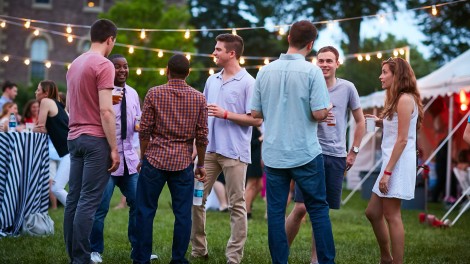
As day turns into night, alumni head to the Quad for refreshments and dancing.
A man holding shiny balloons in the shape of 76 wanders through the late day sunshine soaking the brick path that snakes past Farinon College Center.
Meagan Regina ’10, ambling through the campus with her husband, Matt Iannone, does a double take.
“Amazing,” she says.
Only six years have passed since she graduated with a psychology degree, but so much has happened. Today she works for the U.S. Navy, training sailors how to operate diesel engines.
While she was a student, a friend, Melissa, set her up on a blind date. Melissa was dating a young man named Matt. Matt called his friend – which turned out to be Matt Iannone – and asked if he could take Regina to a formal at Lafayette.
Three years later, Iannone and Regina were married.
Regina worked for a short while doing corporate training for a bank in Manhattan, but wound up landing her job with the Navy.
Keeping tabs on classmates and campus goings on is easier for the internet generation, so Regina wasn’t shocked by Lafayette six years later.
“It’s different,” she says. “It seems like every year a new building goes up.”
As for the couple who set up the couple on their first blind date, “they broke up,” Regina says. “We made it.”